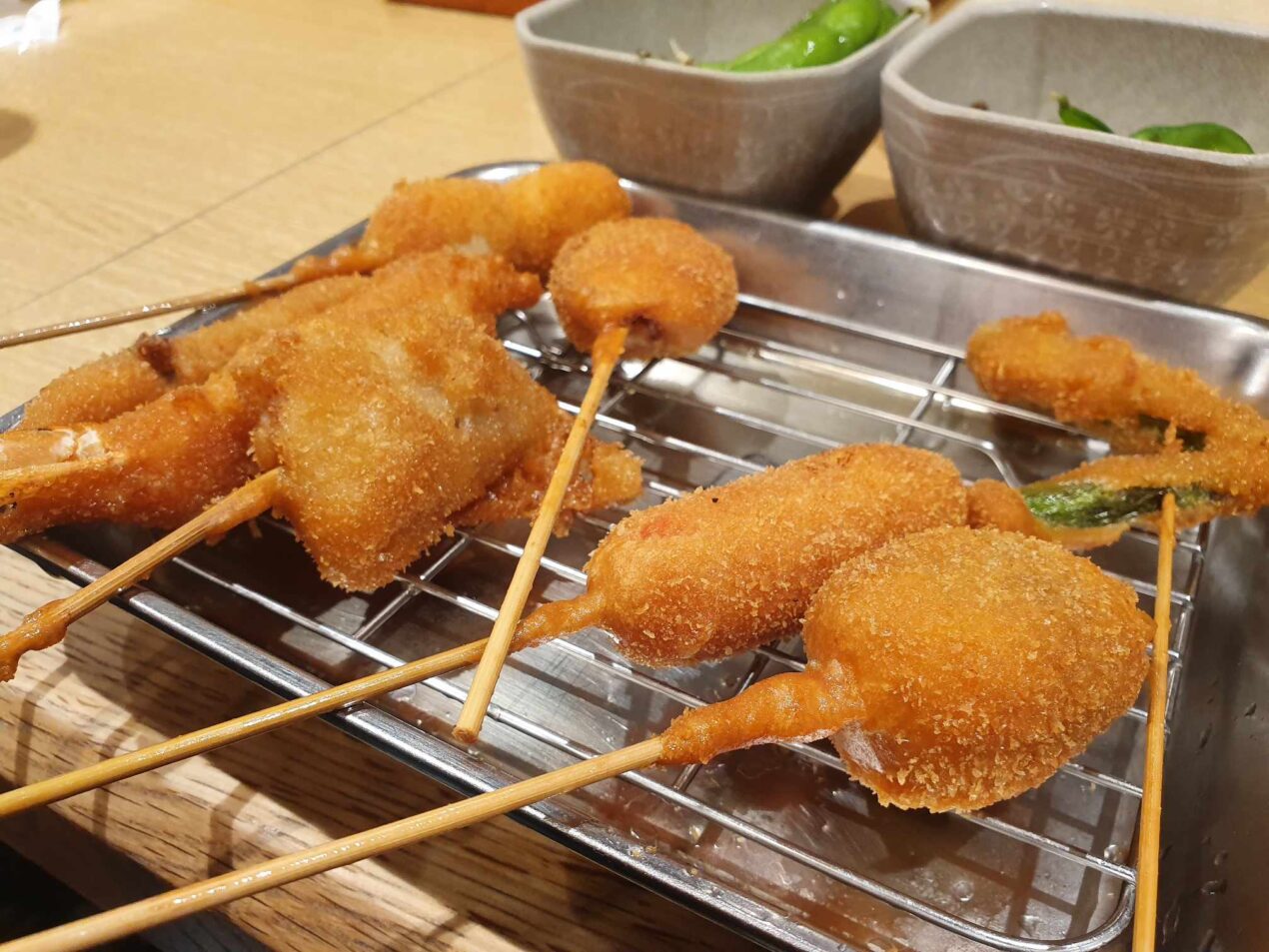Why Kushikatsu Should Be on Your Osaka Eating Bucket List
If you couldn’t already tell by my name ‘Big Body’, there are several types of foods that took me from just a slightly plump little boy to the hulking, bipedal Sasquatch-lookalike (but more like that one from the famous blurry Sasquatch video), the main culprit being fried food. While I’ve dialed my fried food consumption back over the years, I’ve still been known to crush a KFC family bucket in a dark corner of my apartment similar to Gollum in Lord of the Rings when he savagely tears into a fish after catching it. My precious….11 herbs and spices.
So you can imagine my excitement when I learned of a popular deep-fried dish called ‘Kushikatsu’ that was said to be at the heart of Osakan identity, having first originated as an affordable, filling, and quick meal for Osaka’s blue-collar workers in the early 1900s. During my three months living in Japan, kushikatsu became somewhat of a regular occurrence and/or stop on a big night out to fuel up (in both liquid and solid form), without breaking the bank.
Forget tempura. You’re in the world of kushikatsu now.
Below, I’ll walk you through what exactly kushikatsu is, a little history behind it and why it’s beloved in the Kansai region, the one faux pas you shouldn’t commit while eating it, and a bit about an unforgettable kushikatsu omakase experience that I booked several weeks in advance along with a must-try kushikatsu staple and chain in Osaka.
Pale Ale Travel Note: This article is strictly talking about kushikatsu in Osaka (the de facto kushikatsu capital), as I did not have the pleasure of consuming it anywhere else. Also, I will be using ‘kushikatsu’ and ‘kushiage’ interchangeably throughout the article.
Kushikatsu: a Working Class Osaka Staple
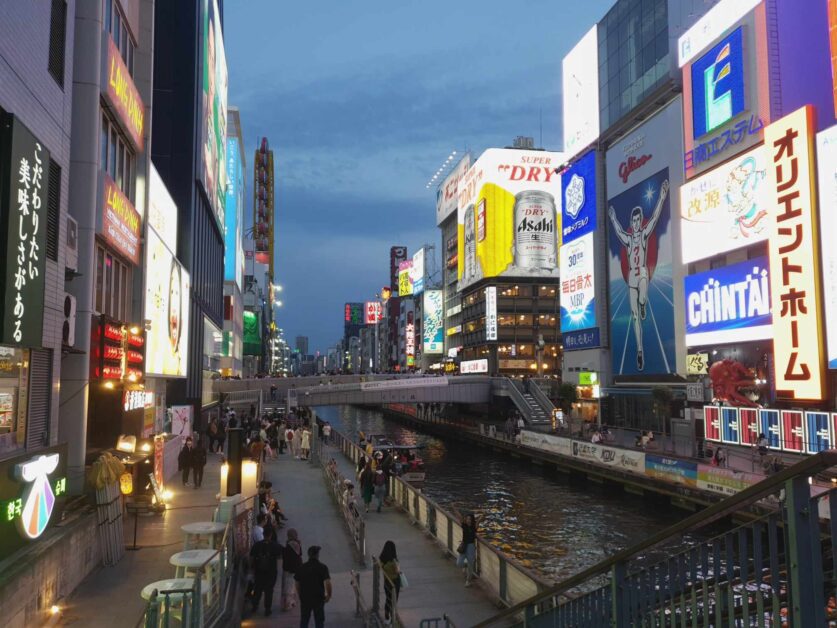
At its core, kushikatsu (also referred to as ‘kushiage’) is deep-fried meat, protein, and vegetable skewers served “as is” or with an accompanying tonkatsu sauce (a soy sauce and Worcestershire base). “Kushi” refers to the bamboo skewers that the meat, seafood, and vegetables are skewered on, while “katsu” simply means ‘fried cutlet of meat.”
You’ll find everything from standard meat offerings like chicken, pork, and beef, to assorted vegetables like asparagus, onion, and yams, all the way to horse meat, quail egg, and even dumplings and smoked cheeses – all delivered in golden brown, skewered form. Kushikatsu has more range than Steph in the 4th, 27 feet out with Russell Westbrook bearing down his throat.
It’s also typically served with diced cabbage as a palate cleanser and digestion aid.
In Osaka, kushikatsu offerings are skewered as a single food, meaning that this ain’t the Turkish or Greek lamb kebabs you’re used to, with tomatoes, onions, and peppers layered across the skewer. Other regional takes on kushikatsu, such as ‘Tokyo kushikatsu’ alternately skewers meat and vegetables. Because they aren’t particularly large, it’s common to eat the skewers by the bouquet-full.
As kushikatsu restaurants are primarily casual and countertop-style, you’ll often find a “communal” sauce (the soy and Worcestershire sauce hybrid) pot to dip your skewer in. Several kushikatsu restaurants I went to provided brushes for patrons who wanted to Bob Ross their skewers instead of dunking them.
Punishable by death under Japanese law, diners are prohibited from double dipping their skewer in the communal sauce pot after taking a bite. This is just common hygiene practice right here and I am entirely in favor of corporal punishment for committing such a heinous act. The trick is to use a slice of cabbage to gather up additional sauce (if needed) and coat your half-eaten skewer that way.
A Brief History of Kushikatsu

First introduced to Osakans in 1929 at a small food shop in Shinsekai, kushikatsu was spawned out of the need for an affordable answer for low-income and working-class workers in the south of Osaka. Shinsekai, aptly translated to the ‘New World’, sits just south of Osaka’s downtown (aka Dotonbori, Nipponbashi, and Namba), and was created in 1912 as an entertainment district.
Interestingly, Shinsekai was modeled after ‘New York’ (Coney Island of all places) to its south and Paris on the north side – with its beacon of hope and light being the distinguished Tsutenkaku Tower (formerly the second tallest building in Asia – many many moons ago).
There is a deep pride taken in kushikatsu as it was integral for feeding those driving the redevelopment of Japan in the aftermath of World War II. Shinsekai was somewhat of the forgotten district of Osaka when it came to redevelopment and is still considered one of Japan’s poorest neighborhoods to this day – with Nishinari (just to the south of Shinsekai) often referred to as the ‘most dangerous neighborhood in Japan’ (which I can tell you is not really the case at all).
In my humble opinion, Shinsekai is one of the most personality-packed areas in all of Osaka.
Pale Ale Travel Tip: If you want to ensure that you try another must-try Osaka specialty, make sure to check out my post breaking down my favorite takoyaki (fried octopus ball) shop – Takoyaki Umaiya.
From the rundown pornography theaters to bustling mahjong and shogi clubs and pachinko parlors, multicolor signage, and blast from the past, retro Janjan Yokocho (shopping street), it is the main spot in Osaka that I felt like I stepped back into time (but in the best way possible) and caught a glimpse into how more people in Japan actually live than you think (I always thought life in Japan would look like something out of Blade Runner).
Pale Ale Travel: If you’re feeling piggish and want to keep the “katsu” trend going, make sure to check out my post breaking down two of my favorite tonkatsu restaurants in Osaka.
Kushikatsu vs. Tempura: What’s the Difference?
Don’t you dare call it tempura. Unlike tempura which uses a batter consisting of water, flour, and eggs, kushikatsu uses a thicker and stronger flour, water, eggs, and panko breadcrumbs. This creates a more robust skewer that can withstand an aggressive dunk in the accompanying sweet and tangy brown sauce. Both tempura and kushikatsu are typically fried in vegetable oil.
For me, the biggest difference is how I feel afterward. After eating tempura, I’m still able to bob and weave like Ali in his prime because I feel as light as a butterfly. After eating kushikatsu, I’m well stuffed and prepared for a big night on the town, with a substantial base in my stomach to sop up the gallons of Japanese beers (nama beerus) I’m yet to consume.
Pale Ale Travel Tip: If you’re in the mood for a light, crispy, quality tempura (and duck), make sure to check out my post ‘Damn I Hate Being Soba’ which includes one of my favorite restaurants in the Temmabashi area.
Kushikatsu Daruma

Website, Address, & Details: https://www.kushikatu-daruma.com/tenpo_sinsekai_honten.html
- Location: 2 Chome-3-9 Ebisuhigashi, Naniwa Ward, Osaka, 556-0002, Japan (Shinsekai Main Branch).
- Price: $ – Cash Only*
It’s tough to not spot a Kushikatsu Daruma branch when you’re in Osaka (and even Kyoto) as they are scattered across the city by the dozen. They are easily identifiable by their signature mascot plastered outside (and on top of the shop), an angry man wearing a black hachimaki (headband) and holding two kushikatsu skewers in an X shape – a reminder to not break the golden rule at kushikatsu and double-dip it into the communal sauce elixir.
However, the main shop in Shinsekai is my favorite and is where I’d go for my deep-fried skewer (and nama beeru) fix. Having first opened in 1929, Kushikatsu Daruma is kushikatsu. Full stop. With skewers clocking in at just 150 yen (USD 1) and having so much flavor (and grease) packed in the confines of a single golden brown stick, it’s no surprise why Daruma is almost synonymous with the term kushikatsu when you come to Osaka.
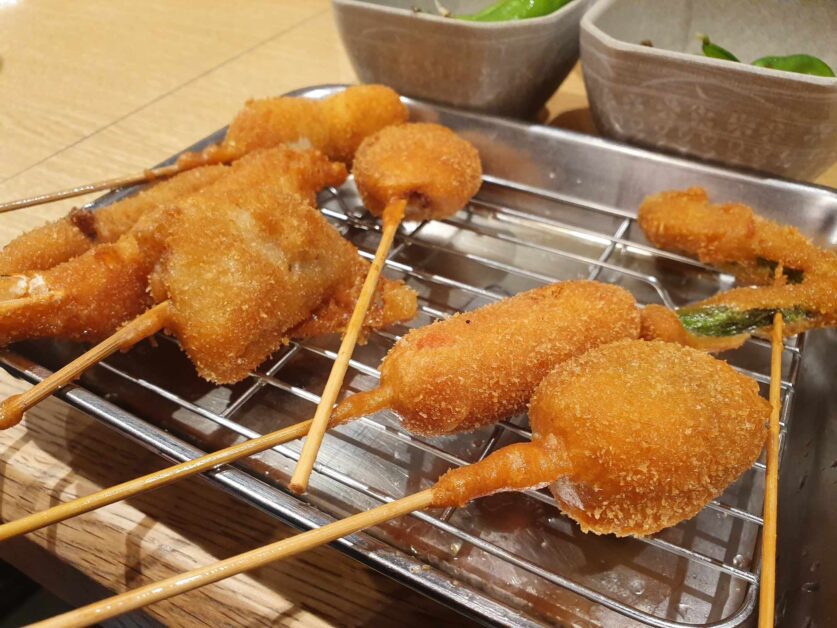
If you’re unsure of what to order, you can choose from one of several kushikatsu sets (which start around 1,700 yen) and leave it up to the kitchen to pick your skewers. However, it really doesn’t stand to save you much skrill, so I’d generally recommend ordering your skewers a la carte.
My personal favorites include their classic beef, pork cutlet (tonkatsu), asparagus, camembert, and chicken meatballs. I mean, take an already fantastic skewer and then fry it in high-quality oil after a liberal dunk in batter and sit back and enjoy the juicy (or gooey), well-preserved interior.
Finally, I know I went hard in the kushikatsu paint over not double-dipping but as of my last trip to Kushikatsu Daruma in July 2023, they switched over to squeeze bottles for the sauce. If I were a betting man, it would be for hygiene purposes. I’m not going to even imagine what sort of alien creature would develop by the end of a shift after catching spray back from several hundred sneezes throughout the day.
Pale Ale Travel Tip: The Kushikatsu Daruma main branch in Shinsekai is also home to one of my favorite runs in all of Osaka. If you’re looking to burn a few calories before a big night of eating and drinking, make sure to check out my post breaking down my favorite running routes in Osaka.
Kushikatsu Gojoya
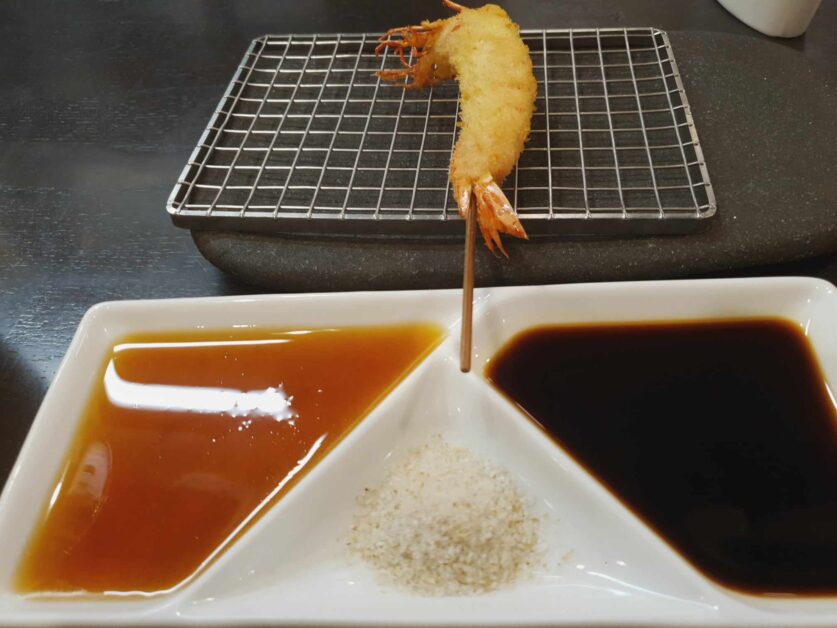
Think of the crunchiest prawn/shrimp tempura you’ve ever had and then multiply that by five.
Website, Address, & Details: https://94katu5jyoya.com/
- Location: 2 Chome-1-11 Uchihiranomachi, Chuo Ward, Osaka, 540-0037, Japan
- Price: $$ – Cash Only*
Having first fallen in love with kushikatsu at Kushikatsu Daruma, and made more than a handful of pilgrimages down in Shinsekai, there was a term that caught my eye – ‘kushikatsu omakase’. Mix that in with the fact that I had just come hot off my first omakase experience in Bangkok and one of the best culinary experiences of my life, my stomach knew Kushikatsu Gojoya was in the cards even before my brain did.
Translating to “leave it up to you” (or “chef’s choice”), Omakase is a popular phrase and also a style of restaurant where diners defer to the chef to select seasonal and curated selections for their meal. It’s a sensual gastronomic dance led by the chef, where the highest quality ingredients are put forth before the diner, often with an explanation and quick Q&A – after which, the chef strives to read what you might like next based on your feedback and comments. This is all in the name of the optimal gastronomic experience.

If I could remember exactly what this was I would tell you.
Kushikatsu Gojoya was an elusive restaurant for me, and had me feeling like a hairy, plump little satyr in pursuit of a water nymph (minus the flute), always coming up empty in my gustatorily cavorting attempts. Due to its popularity and limited seating (primarily countertop seating), reservations are a necessity. Add in my poor timing (as it was Golden Week in Japan), I was only able to snag a reservation for several weeks out.
It was worth the wait and a highlight of my three-month eating adventures in Japan.

See comment for above picture.
Kushikatsu Gojoya takes an innovative approach to this classic cuisine, incorporating international ingredients and influences into every single skewer. You’ll find everything from Italian-inspired pizza and risotto skewers to French truffle and escargot, and even American dessert classics like carrot cake and banana cream pie.
The ability to take an otherwise simple concept and elevate it with contrasting, explosive flavors that shouldn’t work but do is the defining factor of what separates Gojoya from any other kushikatsu restaurant I tried during my Japan tenure.
Diners select from one of four sets and will receive their kushiage until they either finish their set or tell the chef to stop.
- 10 pieces,
- 15 pieces,
- 20 pieces,
- 25 pieces.
Prices range from roughly 1,500 yen (USD 10) for the 10-piece set to 4,000 yen (USD 27) for the 25-piece set. I, of course, opted for the 25-piece kushiage set as I had been fasting all day and wrapped up a lengthy run around Osaka Castle.
I would love to recount exactly what I ate below in great detail but, like clockwork, I did have roughly 10 Heartland draft beers (by Kirin) that night and just tried to live in the moment. Here are a few of my favorites.
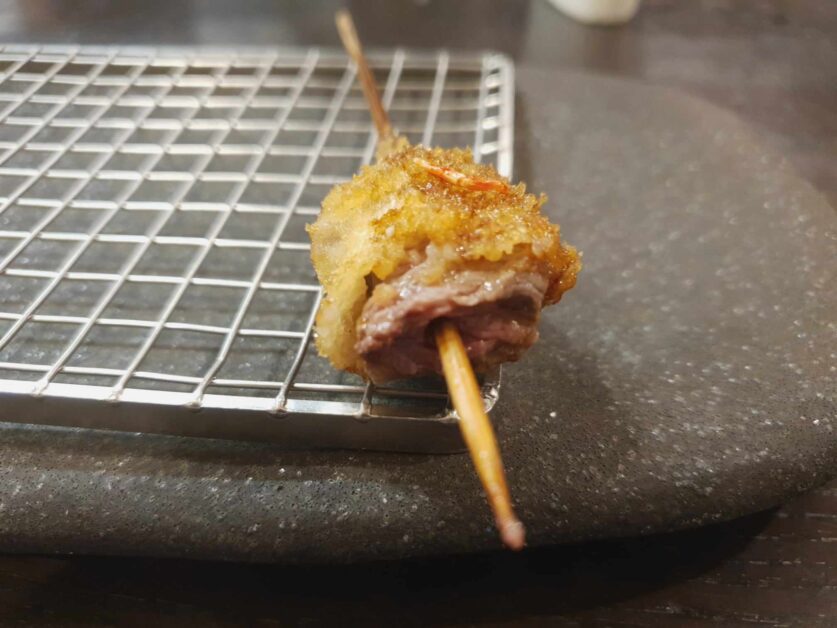
The signature beef kushikatsu – I honestly prefer this over the gyukatsu (fried beef cutlets), which I ate over at Gyukatsu Motomura.
Because I speak roughly two words of Japanese, I mainly just hit the chef with an “oishii” (delicious) for the dishes that I liked and an “oishii, oishii” (delicious, delicious) and an enthusiastic thumbs up for the ones I loved.

You’ll see below that the staff at Kushikatsu Gojoya was extremely accommodating and merciful, going so far as to translate every single item on their phone with a short explanation.
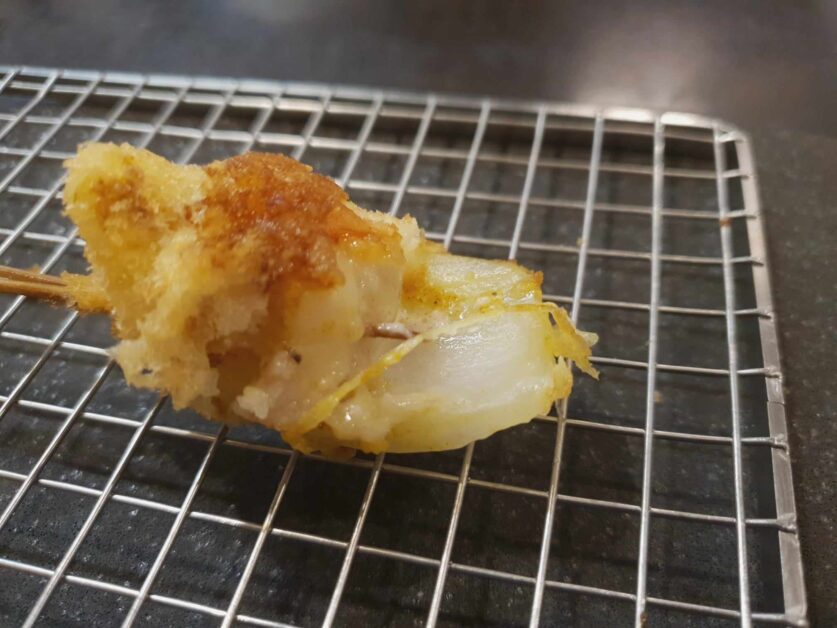
Who knew cod and potato in pizza form could be so damn delicious?
Half the time I had no idea what I was eating based on how it looked but was usually able to arrive in the ballpark after taking a bite – Kushikatsu Gojoya’s ability to recreate familiar bites with unique and non-traditional ingredients will leave you Cris Angel Mindfreaked by the end of it.

Dessert is served. Some sort of banana cream pie sorcery that made me feel like I was eating a whole slice.
Keep in mind that Gojoya uses seasonal ingredients and is constantly changing up its menu and coming up with new creations, so what you see below likely won’t be on the menu if you make the trip.
Pale Ale Travel Tip: Kushikatsu Gojoya is only a stone’s throw away from several of my favorite ramen shops in all of Osaka. I compiled an ‘Osaka Ramen Bible’ which I’d recommend giving a read if you’re in the market for every type of ramen known to mankind.
Get Your Tushy-katsu Over For Some Kushikatsu
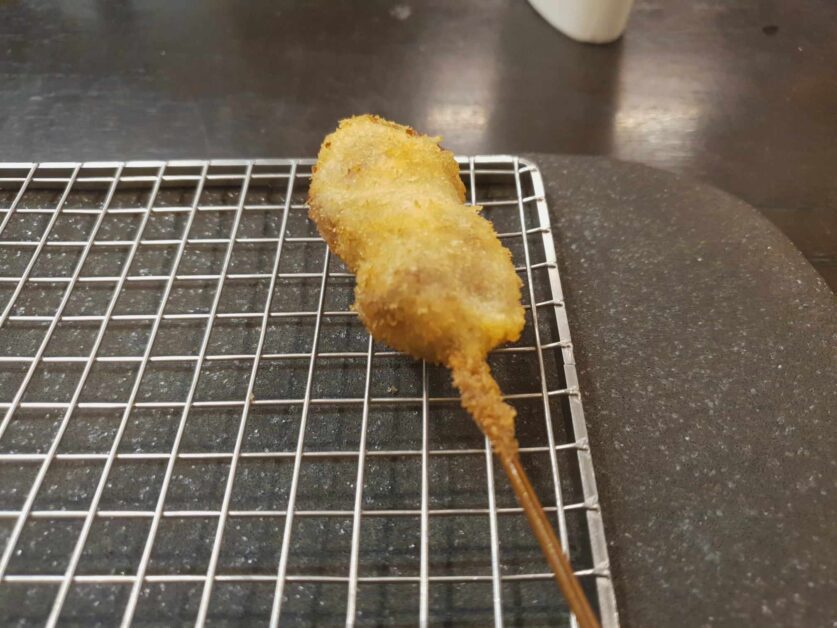
As someone who grew up an ardent supporter of corn dogs, not just because they taste great but because they were easily eaten “on the go” thanks to their advanced ‘skewer technology’, I practically have skewered food running through my veins. Kushikatsu far surpasses whatever frozen corn dog I would defrost in the microwave as a young thick buck and adds a much-needed element of communal joy to fried food consumption.
It’s simple (at its core), it’s affordable, and it’s damn delicious. It exists at the heart of Osaka’s identity and is a food that honors those who built and made the city what it is today. It’s perfect for those nights when you want to cozy up next to your top dawgz, slug a few cold ones, and eat your fill (without needing to request an emergency loan from your friend just so you can make it through the month). For me, it doesn’t get much more special than that.
If you’ve tried kushikatsu, I’d love to hear from you in the comments. How did you find it compared to tempura? Which do you like better? Do you have a favorite kushikatsu restaurant in Japan? Also, if you have any questions about finding a kushikatsu restaurant in Osaka, don’t hesitate to reach out to me!
Eat well everyone,
Big Body
Big Body is a voracious lov…eater, a cowardly fighter, and a self-proclaimed curry goat BBQ-eating champion (don’t forget the donkey milk) who likes Stoicism, baseball, and writing in the third person. Having worked for himself for the last 7 years, he isn’t particularly successful but he does still drink ice-cold Sapporo draft beers with the best of them and knows his way around a Dai Pai Dong or two. He is based in Hong Kong but you can still find him in Saigon, Osaka, and Vienna for extended periods.
